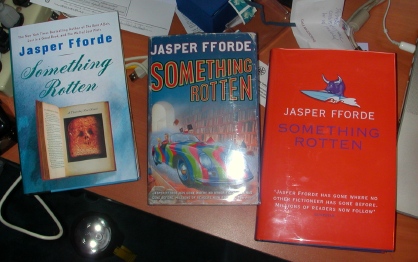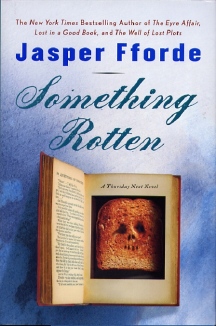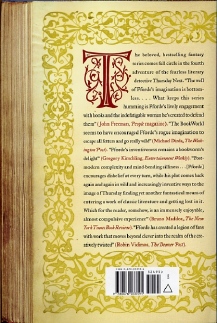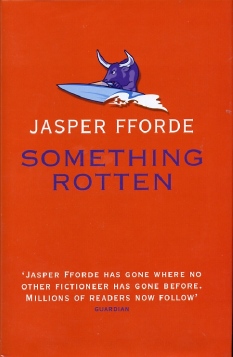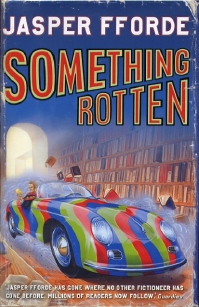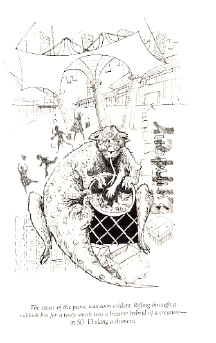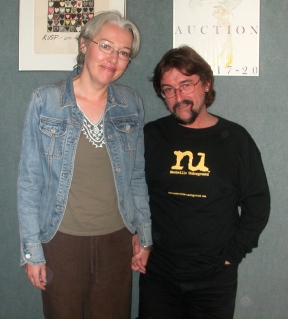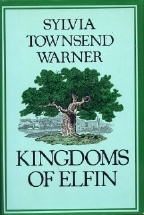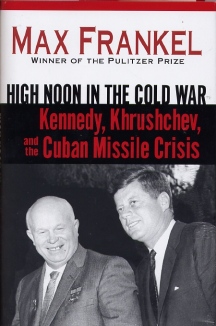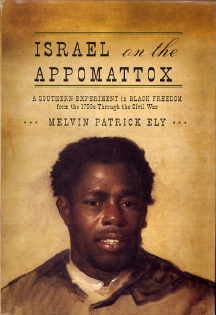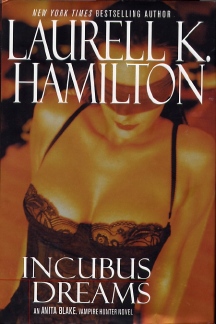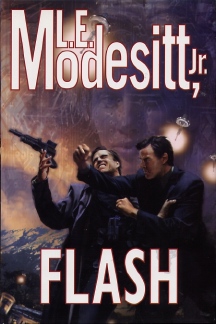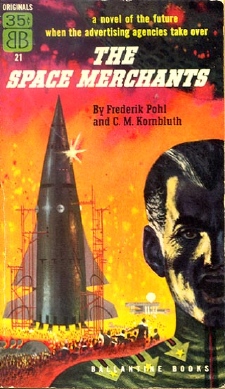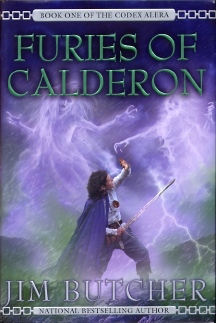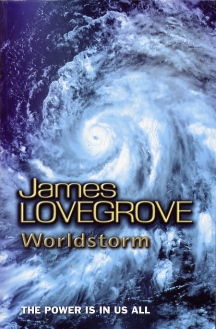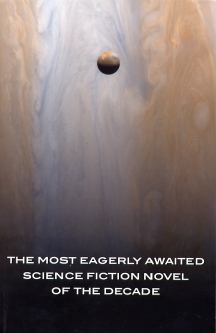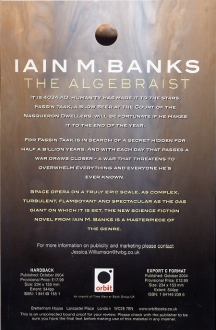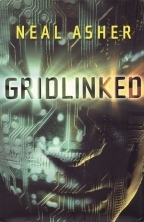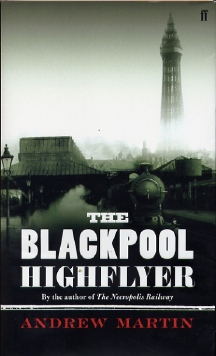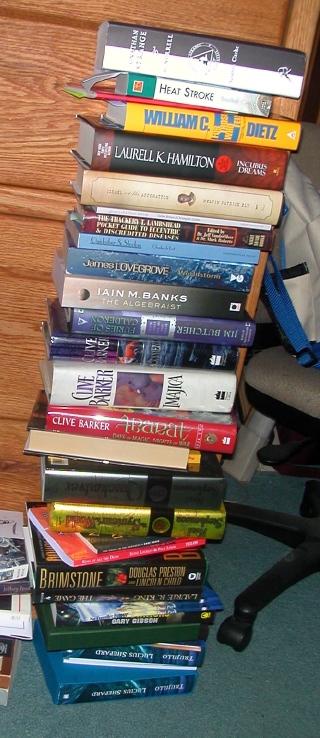|
|
|
This Just In...News from the Agony Column
'Something
Rotten' This Way Comes
Readers will have to excuse the inexcusable delay for this article, which has been in the planning stages for what -- five months now? Well, as long as I knew that there were going to be a bevy of choices when it comes to first edition hardcover copies of Jasper Fforde's latest Thursday Next novel, 'Something Rotten'. Fforde and his publishers both here in the US and in the UK have managed to put together a series of editions that serve all readers on both sides of the pond equally well, and for those who are rabid collectors -- and I suppose in this case, I'll cop to that description -- well, there's a cornucopia of great news.
First and foremost, what readers need to remember is that the best news is simply that there's a new novel by Jasper Fforde. Hell, they could release it in an eye-killing PDF-file for your palmtop and it would still be prose written by Fforde in an extension of his Thursday Next series, and thus, quite likely to be great work. That said, I haven’t read it yet. But I've got over the worrying stage as far as Fforde's work is concerned. He's getting better and better. I don't see this as being anything less than another outstanding entry, even if you have to read printouts from your office's fax machine. But lucky you, wherever you are. You'll not be reading printouts from the office fax machine. As I discussed before, Harper Collins and Hodder Stoughton were, well almost in sync in releasing this novel in hardcover on both sides of the Atlantic. In point of fact, the US hardcover was available in the US slightly before the UK version, and the reason that I've waited so long to run this compare and contrast article is that I've been waiting on my UK copies, which just arrived yesterday afternoon in a big honkin' box. So now I've got all three lined up here on the desk at Agony Column HQ for a hands-on compare and contrast. No sitting round looking at JPEGS. This is the real deal, all scanned early this morning for your delight. First, let's look at the general release data and format. The US hardcover of 'Something Rotten' (Viking / Penguin Putnam; August 5, 2004; $24.95; ISBN 0-670-03359-6)) is 6" by 8.5", and it's 392 pages long. That includes all the advertisements and a page with only the suggestion that the reader "Look for the next Jasper Fforde adventure in 2005." That page is not in either of the UK editions, but don't get too excited. It's just Times-something font set in the center of the page, and other than the ambiguous wording doesn't tell us anything we couldn't have guessed. Speculations are to follow. The UK Royal Hardcover Limited Edition, also known as the UK Collector's Hardback Edition, (Hodder & Stoughton; July 28, 2004; £18.99; ISBN 0-340-82597-9) is the largest of the three editions. It's 6.5" by 9.5", and it's exactly 400 pages long, with no "Look for the..." page. Spine lettering reflects the design on the dust jacket. However, here's something to note; it doesn't show up in the *.* search. And I can't find anything about Fforde on the Hodder Headline homepage. The UK Hardback Edition (Hodder & Stoughton; July 28, 2004; £12.99; ISBN 0-340-83558-3) is the smallest of the three editions at 5.5" by 8". The pagination and layout is precisely the same as that of the Collector's edition; the font and leading are smaller. Once again, spine lettering reflects the design on the dust jacket. It does show up in the *.* online catalogue. Of course, all three editions have different covers. Fforde states on his website that the cover for the UK Hardback edition is "pretty much what I had in mind for the first book". And yes, it is pre-scuffed for your entertainment. Of note is the back cover of the US edition, with faux pages so real I had to look twice to make sure the book wasn't mis-aligned when I scanned it. What readers and a certain subset of collectors want to know is the variance between the various editions on the inside. For the UK editions there is no difference. Pagination, layout, adverts at the back -- they're entirely, one hundred percent the same. And while there are differences between the US and the UK editions they are decidedly minor. The US edition features a larger Fahrenheit 451 warning up front, and that tantalizing final page. The UK editions also now display some of the chapter-starting quotes on faux torn-off pages; the US edition displays them all as text. All the editions come with some very nice little line illustrations, six in all, by Maggy Roberts. The upshot of this is, if you're a reader, and not a collector, that any of the three editions will do just fine. There are the differences in physical size between the two UK versions, and you may want to wait for the large-print version (if you can wait), or opt for the Collector's edition (if you can find it). Other than that, congratulations are due to Fforde and his publishers for making things largely equal on both sides of the pond for all readers.
No, for me, it's a couple of shots of the Hardcover Collector's edition, one of the trade hardcover edition, and one of the US edition. With that, I'm good to go, and that should hold most of you. The rest of you-- give some money to charities. You don't need to buy proof editions of these books. On the other hand, everybody, everywhere should give Jasper Fforde a run. Fforde is brilliant in a way lots of smart people aren't. He knows his strengths and he plays to them. He's kept an imaginative series fully engaged and engorged, getting better but not necessarily bigger. Fforde's not just a great writer, a fun writer, but he's an important writer as well. And busy -- just look at that damn website of his! Really, it's a good thing he has a Boss Coming button on his pages because you can spend a couple of weeks paging through, and if it were a pay site, then it would be worth every penny and then some. And no, you don't need a Boss Coming button for this website, do you? I mean -- your boss is reading this website too! If not, tell them to do so -- they'll thank you and so will I. |
|
09-30-04:
A Conversation With Susanna Clarke; Max Frankel's High Noon in the
Cold War; Melvin Patrick Ely's 'Israel on the Appomatox'; Laurell
K. Hamilton's Incubus Dreams |
||||||
A
Brief History of Faerie
As an interviewer, one never knows how an interview will fare. One can prepare as much as one wishes, but in the end, to my mind, the interview is about the author and my job is just to give the author the chance to say something about what interests them and what brings them to write books we enjoy so much. Susanna Clarke and I talked mostly and at length about the world of Faerie. She did some fascinating research into the matter, and told me all the great and gritty details. As usual, readers can find this interview in MP3 or RealAudio format.
For readers wishing to delve deeper into the world created in 'Jonathan Strange and Mr Norrell', or those who wish to understand how she created the novel, or those who wish to hear her asked questions she'd not been asked in other venues, I think you'll find some solid material here. Susanna Clarke is going to continue to bowl the world over with her own re-invented world. I'd suggest that readers get in on the first floor, not fall behind and pay close attention. Great forces are at work here. A door is opening between the worlds. Ms. Clarke is as fine a guide as you can hope for to explore the world of faerie. |
||||||
Kennedy,
Khrushchev and the Cuban Missile Crisis
With a clock ticking back and forth between five till and Nuclear Midnight, with popular Twilight Zone episodes about families forced to eject their neighbors from a backyard bomb shelter, with novels like Nevil Shute's 'On the Beach' and movies like 'Dr Strangelove', and later with short stories like Harlan Ellison's 'A Boy and His Dog', my pre-teen and teen years were a cavalcade of constant fear. You could watch our soldiers being killed while eating dinner from TV trays and then watch prime-time TV about post-apocalyptic scenarios, repeats of the movies mentioned above or episodes of 'The Outer Limits'. If you weren't going to be killed in a war in the short term, chances were you'd be killed in a war in the long term. You could do nothing about it. The American government was your friend, they were trying to save you, but the prognosis was clearly not very good. Hide under your school desk, or in a hole in the back yard. If you were lucky and survived the initial strike, you could look forward to a hideously painful and ugly slow death afterwards. Once again, we live in an age of government -approved terror. With Nine Eleven as the new Cuban Missile Crisis, our government is once again our friend and nukes are once again our enemy. No hiding under the desk this time, though. You're almost literally instructed to pray it happens elsewhere -- or that if it happens near you, you want to be close enough so that you can become an instant shadow on the sidewalk, rather than a traumatized survivor. My guess? Lots of those air raid sirens still work. And I know our Emergency Broadcast System still works, and it still sends a chill when I hear one. All of this goes to say that perhaps understanding the starting point of the last campaign of national fear is a study worthy of more than an exercise in nostalgia. There have been a number of pretty fascinating books out recently on this subject, and the most recent is Max Frankel's 'High Noon in the Cold War: Kennedy, Khrushchev and the Cuban Missile Crisis' (Presidio Press / Ballantine Books / Random House, September 28, 2004, $23.95). At a slim 206 pages, it looks to be as much a toe-tapping exercise in terrorizing reality as it does a clarification of the myths that have risen around this so-called "exercise of nuclear chicken". Max Frankel is an iconic and Pulitzer Prize winning newsman. He worked for The New York Times for fifty years. Rising from a college correspondent, he eventually became executive editor. He was there. He covered the story for the New York Times. Now he's gone back, using his personal notes from the time, newly-released records and interviews with players from both the United States and the Soviet Union, to re-construct and newly analyze what happened then and why. His take is that we weren't as close to nuclear war as others would have us believe. Leadership from both Khrushchev and Kennedy kept us back from the brink. In theory, we should feel relieved, but to my mind, it's far too late for that. The anxiety is with us once again, pushed harder, pumped higher. All right children, there's the siren. Now I want you to get under your desks and put your hands on the back of your neck until we call the all-clear. In about, say, forty years. |
||||||
A Southern (and Publishing) Experiment
Melvin Patrick Ely made a pretty big splash with his previous race-based history, 'The Adventures of Amos'n'Andy: A Social History of An American Phenomenom', wherein he carefully studied the creation and the reaction to this radio program. The work was hailed as a careful exhumation of history and a "sensitive and scholarly work". That makes him a pretty good candidate to bring light to the events that unfolded when Thomas Jefferson's young cousin, Richard Randolph, left land to his slaves and created a community of free black men in the midst of a nation where slavery was still legal. Jefferson believed that while slavery was wrong, blacks and whites could not live together. Randolph wanted to prove him wrong. The community he created came to be called Israel Hill.
To my mind, this book itself is something of a publishing experiment. Will readers cough up the significant chunk of change for a compelling and no-doubt controversial work of non-fiction? I'm not sure if they will, though it's certain that libraries should and will. I sure as hell would, but then, I'm obviously something of special case. The last history of this sort I read was the wonderful work 'The Temple Bombing' by Melissa Faye Green, about the bombing of "The Temple", Atlanta's oldest synagogue, when the Jewish community of "it can't happen here" Atlanta found itself caught in the crossfire of a renewed battle between blacks and whites. It was an involving and intense reading experience, the perfect antidote to the science fiction and horror I was reading at the time. As might this book for this time. Your call, readers. Do you want to read about the experiment? Do you want to be in the experiment? |
||||||
A History of the Victoria's Secret Catalogue
The latest Laurell K. Hamilton novel, 'Incubus Dreams' (Berkley Books /Penguin Putnam; $23.95; September 28, 2004) finds Anita Blake back in action of every type you can imagine and a few you might not want to admit that you have imagined. I just popped it open to a random page (303) and found: I'll say. Now, I liked the original set up of these novels, the supernatural sleuth act that seems to get the short shrift these days. I guess I should be and to a certain extent, I am glad that sex, not violence gets the accent here. That's creative and life affirming. But maybe there are ways to be equally creative and life affirming without quite so much sex, and ways to make sex creative and entertaining without well...quite so much of it."Can't we just fuck at home later?" I asked. That said, Hamilton has a huge fan base and she sells books like nobody's business. Except that it clearly is a business and nobody that I know will cop to reading the books. Are you out there? Reading Laurell K. Hamilton? Now I like the writing in these novels, I like the world and I like much of the sensibility. I'm actually quite curious as to what Hamilton herself has to say about these novels, and I do understand that they vary from title to title. Some tilt towards the mystery more, some tilt towards the romantic entanglements of the characters and some tilt towards the hubba-hubba. The nominal subject of this novel is that a vampire serial killer may be preying on -- wait for it -- strippers. Anita Blake is pretty sure that none of her three main squeezes -- not the Master Vampire Jean-Claude, the werewolf Richard, or the shape shifter, Micah, have anything to do with it. But given the intimate nature of her relationship with the characters she' surely not the best judge. In a hothouse haze of lust and deception is she the best woman for the job? While I do think there's a lot of potential here, it's definitely two sided. If you're looking for material as quoted above, I'd say it's a pretty safe bet that you're going to find that and much more. I literally let the book fall open and that's what I found. If you're looking for toe-tapping tension and terror, well there may be a bit of that as well. One of these days I'm going to check back in the Anitaverse and see what's what. In the interim, if anyone needs a writer to supply verbiage for that History of Victoria' Secret Catalogue, I'm available. |
|
09-29-04: L. E. Modesitt, Jr. Is More than Just 'Flash'; Jim Butcher Channels the 'Furies of Calderon' |
||||||
SF
Comments on an SF World
Few science fiction writers, alas, are trying to be as topical as L. E. Modesitt in his latest novel, 'Flash' (Tor Hardcover; $25.95; September 15, 2004). I think that's a shame, because we live in a world ripe for satire. Sometimes it seems as if we are living in a satire, and one is forced to wonder where, exactly, the Real World has got itself off to. Set in the same world created for 'Archform: Beauty', 'Flash' is a far-future saga of political skullduggery and media manipulation. And yes, this is a science fiction novel, not a another non-fiction expose of Things As They Are. Sometimes it's so much easier to be direct and to the point when the action takes place years in the future. The set up of the novel is quite straightforward. Jonat deVrai ("Just call me Johnny Truth"; kidding!) is the kind of guy who walks away from a promising career in the Marines when he witnesses atrocities committed by the US government. (I swear this is science fiction.) Since he's a can-do sort of fellow, he makes it to the big time in the fast-paced world of product placement. But the cover suggests that he can still throw a punch. And he'll need to. When the Center for Societal Research asks him to take a look at a rising star of politics in (you've got to love this -- science fiction, really!) West Tejas, the attempts on his life start, as does, presumably, the punch-throwing. (Not Hawaiian Punch, the cover informs us.) From that moment on, it's a race to the finish sorting flash from fact and weeding out who precisely the terrorists really are. (And yet again I'm reminding you this is science fiction.) All this might be just fine speculation from any Yahoo! or on-line blogger. But Modesitt brings qualifications up the wazoo to write this novel, and not just the qualifications of having written, well, more science fiction novels than I can easily count.
But apparently the world of market research was not unreal enough for Modesitt. No sirree, he became a legislative assistant for a Congresscritter. And then to work as the head of Legislation and Congressional Relations for the EPA during the Reagan-Buford scandals. (Now that really did happen; it wasn't science fiction. This is the non-fiction of the writer's life, got that?) And let me quote from the richly written promotional materials: "During his years in the nation's Capitol, he attempted to regain some hold on reality by writing increasingly more science fiction." This sounds like a recipe for a great novel to me, and I'm pretty interested in reading 'Flash', and seeing if it helps us get a hold on reality by focusing on science fiction. Is that a sorry state to arrive at -- or a desirable outcome? If our world is so science fictional, perhaps we'll just have to read and write more realistic fiction, which, in contrast to the science fiction that surrounds us, will at least manage to seem science fictional. |
||||||
'Book
One of the Codex of Alera', A Fat Hardcover Fantasy Series For Jim
Butcher
Tolkienesque fantasy, that's what. The setup here is pretty simple and rather ingenious. The people of Alera bond with the furies -- earth, air, fire, water and metal -- and command them to battle the aggressive and threatening races of their world. But a succession battle leaves their unity in peril. Barbarians -- not a California governor among them -- are at the gates. Apparently, they're not going to fall for the old "You need an E Ticket" routine. Summat's got to be done. And of course, the best person to do it is a kid from the beyond the burbs (so to speak) who has no fury-power whatsoever. For me, fantasy rises and falls in part on the monsters the author brings to the party. That's why Miéville is such an immediate draw -- as he himself said, "it's all about the monsters". From what I can discern here, there are some monsters at least -- spider-critters that attack our protagonist at one point. And the furies that help our friends don't look too shabby either, not judging by Steve's Stone's cover illustration. Given that Butcher's been spending his paperback time fighting monsters one is given to hope that he continues this in the hardcover fantasy realm. For many readers, what is likely tot make this an enticing read is the potential for seeing Butcher's page-turning prose and plotting applied to the often plodding realm of fantasy. Butcher knows how to keep the toes a-tapping, and if he carries that skill into his fantasy, again, there's reason to hope that this will stand out from the usual Tolkien clone activity. In the end, what is certain to distinguish this novel from others of its ilk is not just the monsters, the plotting, the prose -- it's most likely to be the characters. If Butcher's Tavi the Furyless can get under the reader's skin, under the radar, then Butcher is as likely to succeed in fantasy as he has in the supernatural sleuth game. And for those who might worry that he's giving up his Dresden work, his website confirms quite the opposite. He's running a poll to see who readers most want to feature in the next novel. So readers can look forward to double paperbacks next summer -- the MMPB of the current fantasy and the MMPB (one hopes) of the next Harry Dresden novel. And of course, the first sequel to 'Fires of Calderon' -- in hardcover, no doubt. |
|
09-28-04: 'Ware the 'Worldstorm'; Iain M. Banks Stands Alone With 'The Algebraist' |
|||||||
A
Message for the Fire-Inclined from James Lovegrove
While the cover does show a rather ominous picture of what many are saying is currently being used to punish -- and warn -- America for voting irregularities in the previous presidential election, my intuition is that another type of storm altogether is brewing in Lovegrove's novel. And I've got to say, I love, absolutely love a back-cover blurb that doesn’t give away the store. Is it a fantasy or a science fiction novel, or does one merge, or sneak up on the other? In general, I try to eschew quoting DJ notes because they give away far too much. In this case, I'll, make an exception, because Lovegrove's cover-writer ain't giving away nothing.
What the hell? In 'Worldstorm', you do get a fantasy-styled
map, but I'm pretty sure this is not swords and damsels extravaganza.
The Four
Inclinations
-- I'm inclined to think -- include Earth, Air Fire and Water. I'm
pretty sure the Fire-Inclined have some influence over flames, and
the rest --?
Who knows, and that's just what the joy of reading Lovegrove is all
about. He's got an incredibly detailed world setup here, a science
fantasy, I'll
say, at a compact 452 pages. And what's best about Lovegrove is that
you have a pretty damn good idea that this is not just the first
doorstop on
the way to a trilogy. In fact, you can guess you've got a self-contained
world in a single novel that's shorter than your average fantasy/SF
trilogy-opening terror. Exactly what kind of storm is brewing in
Lovegrove's latest? It's
safe to say that it's a wordstorm. Devastating to experience; buckle
down and wait for the next one. |
|||||||
A
Non-Culture Standalone SF Novel from the Patient Zero for Modern British
Space Opera
Yes, one of the great, and oft-mentioned lacunae in my SF reading is about to be filled. I own a fair amount of Iain M. Banks' work. Last year, I bought a used hardcover first-edition copy of 'Consider Phlebas' from Mark V. Ziesing books, the first of Iain M. Banks novels of "The Culture". Largely regarded as the father of British Space Opera As We Know It, Banks has a fairly significant backlog of Culture novels for me to read were I to be forced to play catch-up. But fortunately for me, I'm issued a pass with his latest sweeping science fiction novel, 'The Algebraist' (Orbit / Time Warner, October 1, 2004, £17.99 Hardcover, £12.99 Royal Paperback). While it's not a Culture novel, 'The Algebraist' is a big (534 page) science fiction novel set in the year 4032, when a star-faring humanity has created a civilization spread across the galaxy. And beyond that, things get pleasantly murky. By that I mean that once again, we get a well-constructed set of DJ notes that tell us enough to get us interested and not enough to spell out the story blow by blow. What doe we know? Fasssin Taak is a slow seer at the Court of Nasqueron Dwellers. He's in search of a secret that might incite or prevent a war. That's about all the cover tells you. I'm pretty sure that we've met the intelligent inhabitants of gas giants, and they're not quite as cuddly as the little flying teddy-bears that we find in say, **.
|
|||||||
|
09-27-04: New Edwardiana; My Mini-Life in the Bush of Books Part 2 |
||||||
One Baroque Step Beyond With Andrew Martin's Railroad Mysteries
And that's why I write this column. Of course, I'd never heard of Andrew Martin? How could I have? Not published in the US, and not headlining in the UK -- yet -- he'd written what looks like two ideal novels for me to read and were it not for the intervention of my across-the-pond correspondent, he'd have remained a mystery to me. Not content with mentioning, he managed to have them appear in my mailbox. Good thing, because the deluge of reality (and the unreality of my own spending habits, see below) might have resulted in these utterly wonderful-looking novels being lost in the encroaching tidal wave of books. Fortunately the physical presence of the novels intervened. And if they come your way, I'm thinking they'll intervene in your intended reading schedule as well. Here's the score. The first novel, 'The Necropolis Railway' (Faber & Faber Trade (Royal) Paperback, July 3, 2003, £6.99) is set in 1906, when railwayman Jim Stringer gets his new assignment. He's working the Necropolis Railway, which was the subject of a Fortean Times article late last year. Back then, I commented that it seemed to be an ideal setting for a horror story. Looks like Martin had already filled that slot.
Stringer does manage to survive his first assignment, only to end up on the cushy side of things in the hise latest novel, 'The Blackpool Highflyer' (Faber & Faber Trade (Royal) Paperback, August 4, 2004, £10.99) issued in a classy package with dust jacket. That's the train that takes vacationers to their seaside resort. Unless of course, it's been derailed. When Stringer investigates, he finds that Blackpool Central is a breeding ground for suspects. And victims. Of course, these novels offer more than a new occupation for an amateur sleuth. (That of a railwayman.) What the railroad mysteries of Andrew Martin most prominently offer is a big, steam-powered slice of Edwardian (as opposed to Victorian) life. Turn-of-the-last-century mysteries set in the grimy world of the average railwayman -- published (thus far) only in the UK. This is practically in the dictionary next to Agony Column Reading Material. I'm going to be getting aboard 'The Necropolis Railway' soon. One hopes that there's a return ticket, if for no other reason than to be able to enjoy the sequel. |
||||||
Saturday's Book Stack
Readers will note some books that are clearly refugees from the Clive Barker Interview, waiting to be re-shelved. They'll also notice some titles that I've not yet got round to writing about. And instead of doing that here, I'm just going to show you picture and tantalize you. Damn me. My job -- and I've obviously accepted it -- is to write about every damn book in this stack that you've not already heard about and that isn't connected with some damn thing in the past. Meanwhile, books will hopefully, theoretically continue to arrive at the rapid rate they managed last week. Problem is that whenever I get ambitious and start doing multi-book wrap ups and news articles, then things get dry and I'm stressing what's to be tomorrow's news, and making very unhealthy trips to the bookstore. All I can say is that it's a good thing I'm not interested in cars. |
